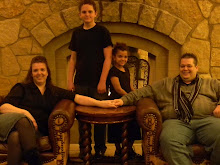 My Dad (we call him Baba, because in his native language of farsi, it means Father) will be going in for surgery on Monday January 12th. He needs to have his Thoracic aortic aneurysm repaired. This will be an open chest surgery..his second chest surgery, his third repaired anyeurysm since the mid 80's.
My Dad (we call him Baba, because in his native language of farsi, it means Father) will be going in for surgery on Monday January 12th. He needs to have his Thoracic aortic aneurysm repaired. This will be an open chest surgery..his second chest surgery, his third repaired anyeurysm since the mid 80's.I need all the prayers and healing thoughts for him. He is a trooper, but still, it will all help.
Here is some info on what is going on with him....for those of you who know him...
What is a thoracic aortic aneurysm?
The aorta is the largest artery in your body, and it carries blood away from your heart to all the parts of your body. The part of your aorta that runs through your chest is called the thoracic aorta and, when your aorta reaches your abdomen, it is called the abdominal aorta. When a weak area of your thoracic aorta expands or bulges, it is called a thoracic aortic aneurysm (TAA). Approximately 25 percent of aortic aneurysms occur in the chest, and the rest involve the abdominal aorta.
A special type of thoracic aneurysm is called an aortic dissection, and is usually associated with high blood pressure. Sometimes, blood flow forces the layers of the wall of your aorta apart, and it weakens your aorta. This process is called aortic dissection and can cause TAA. The separation can extend from your thoracic aorta through your entire aorta and block arteries to your legs, arms, kidneys, brain, spinal cord, and other areas. Another problem associated with aortic dissection is that over time, the pressure of blood flow can cause the weakened area of your aorta to bulge like a balloon. Much like an over-inflated balloon, an aneurysm can stretch the aorta beyond its safety margin.
Thoracic aortic aneurysms are a serious health risk because they can burst or rupture. A ruptured aneurysm can cause severe internal bleeding, which can rapidly lead to shock or death.
Thoracic aneurysms affect approximately 15,000 people in the United States each year. Some patients may have more than one TAA or may also have an aneurysm in the abdominal aorta. Only about 20 to 30 percent of patients who get to the hospital with a ruptured TAA survive. For this reason, it is crucial to treat large aneurysms early, in order to prevent their rupture.
What causes this?
Certain diseases can weaken the layers of the aortic wall, increasing the risk of aneurysms. These diseases include:
Marfan's syndrome, a connective tissue disorder; (This is what he and Veida have, and why he needs the surgery...I will explain this in a later post)
Syphilis; and
Tuberculosis
How is it fixed?
Open Surgical Repair
During open aneurysm repair, your surgeon makes an incision in your chest and replaces the weakened portion of your aorta with a fabric tube, called a graft. The graft is stronger than the weakened aorta and allows blood to pass through it without causing a bulge. Many patients who have a TAA also have heart disease or involvement of the aorta adjacent to the heart. For extensive or complex thoracic aneurysms, sometimes heart surgery is required at the same time as open aneurysm repair depending upon the particular situation.
Following the surgery, you may stay in the hospital for 5 to 7 days. If your aneurysm is extensive or complex, or if you have other conditions such as heart, lung or kidney disease, you may require 2 to 3 months for a complete recovery.
Info gathered from this website



I'll be thinking about you and your dad. I'm sure he'll have excellent nurses like me :) If you guys need anything, let me know.
ReplyDeleteThis message is for Layla, a wallet with all your personal info is been turned in to the Cottonwood Park Village leasing office. Please stop by to pick it up or give us a call with your address if you want it to be mailed. (972) 263-0744 575 W. Dickey Rd. Grand Prairie, Tx. 75051
ReplyDelete